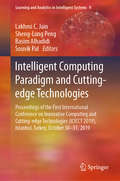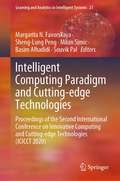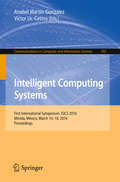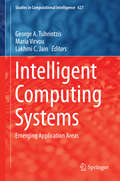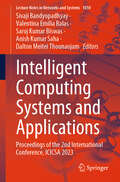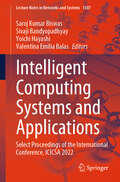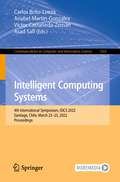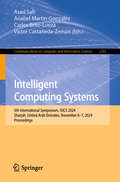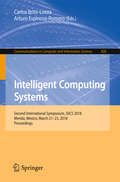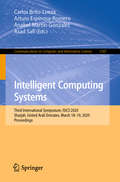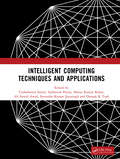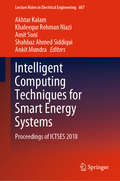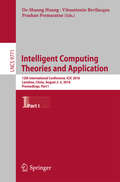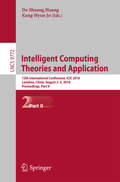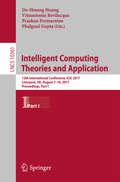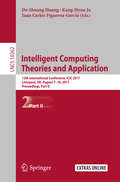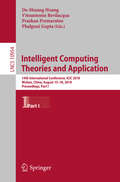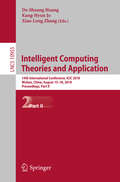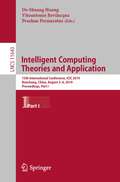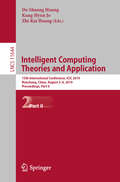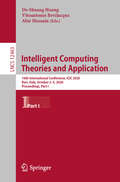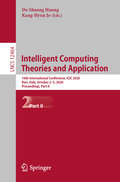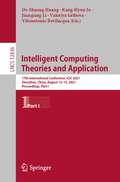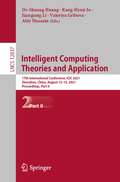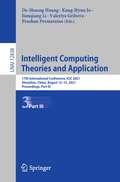- Table View
- List View
Intelligent Computing Paradigm and Cutting-edge Technologies: Proceedings of the First International Conference on Innovative Computing and Cutting-edge Technologies (ICICCT 2019), Istanbul, Turkey, October 30-31, 2019 (Learning and Analytics in Intelligent Systems #9)
by Lakhmi C. Jain Sheng-Lung Peng Souvik Pal Basim AlhadidiThis book discusses fundamental and high-level concepts relating to intelligent computing and communications in the context of distributed computing, big data, high performance computing and the Internet of Things. It is becoming increasingly important to develop adaptive, intelligent, computing-centric, energy-aware, secure and privacy-aware mechanisms in high-performance computing and IoT applications. Serving as a useful guide for researchers and practitioners working in the field of information technology and computer science, the book also appeals to beginners wanting to learn more about the better computing paradigm. In addition, it provides a platform for researchers, engineers, academics and industry professionals from around the globe to share their research findings.
Intelligent Computing Paradigm and Cutting-edge Technologies: Proceedings of the Second International Conference on Innovative Computing and Cutting-edge Technologies (ICICCT 2020) (Learning and Analytics in Intelligent Systems #21)
by Margarita N. Favorskaya Sheng-Lung Peng Souvik Pal Basim Alhadidi Milan SimicThis book aims to bring together Researchers, Scientists, Engineers, Scholars and Students in the areas of computer engineering and information technology, and provides a forum for the dissemination of original research results, new ideas, Research and development, practical experiments, which concentrate on both theory and practices, for the benefit of the society. The book also provides a premier interdisciplinary platform for researchers, practitioners and educators to present and discuss the most recent innovations, trends, and concerns as well as practical challenges encountered and solutions adopted in the fields of Computer Science and Information Technology in the context of Distributed computing, Big data, High performance computing, Internet-of-Things, and digital pedagogy. It is becoming increasingly important to develop adaptive, intelligent computing-centric, energy-aware, secure and privacy-aware mechanisms in high performance computing and IoT applications. This book aspires to convey researchers’ experiences, to present excellent result analysis, future scopes, and challenges facing the field of computer science, information technology, telecommunication, and digital pedagogy. This book aims to attract researchers and practitioners who are working in Information Technology and Computer Science. This book is about basics and high level concepts regarding intelligent computing paradigm, communications, and digital learning process. The book serves as a useful guide for Undergraduates, Postgraduates and Research Scholar in the field of Computer Science, Information Technology, and Electronics Engineering. We believe that this volume not only presents novel and interesting ideas but also will stimulate interesting discussions from the participants and inspire new ideas.
Intelligent Computing Systems
by Anabel Martin-Gonzalez Victor Uc-CetinaThis book contains the reviewed, accepted contributions ofthe First International Symposium on Intelligent Computing Systems (ISICS) that was held in Merida (Mexico) from 16-18 March 2016. We received 25 submissions from 13 countries. Eachsubmission had been evaluated by at least three members of the ProgramCommittee and external reviewers. Based on these reviews, 12 papers wereselected for long oral presentation. In addition to the contributed papers,four keynote speaker presentations were included in the conference program.
Intelligent Computing Systems
by Lakhmi C. Jain Maria Virvou George A. TsihrintzisThis book at hand explores emerging scientific and technological areas in which Intelligent Computing Systems provide efficient solutions and,thus, may play a role in the years to come. It demonstrates how Intelligent Computing Systems make use of computational methodologies that mimic nature-inspired processes to address real world problems of high complexity for which exact mathematical solutions, based on physical and statistical modelling, are intractable. Common intelligent computational methodologies are presented including artificial neural networks, evolutionary computation,genetic algorithms, artificial immune systems, fuzzy logic, swarm intelligence, artificial life, virtual worlds and hybrid methodologies based on combinations of the previous. The book will be useful to researchers, practitioners and graduate students dealing with mathematically-intractable problems. It is intended for both the expert/researcher in the field of Intelligent Computing Systems, as well as for the general reader in the fields of Artificial and Computational Intelligence who wishes to learn more about the field of Intelligent Computing Systems and its applications. An extensive list of bibliographic references at the end of each chapter guides the reader to probe further into application area of interest to him/her.
Intelligent Computing Systems and Applications: Proceedings of the 2nd International Conference, ICICSA 2023 (Lecture Notes in Networks and Systems #1010)
by Valentina Emilia Balas Sivaji Bandyopadhyay Dalton Meitei Thounaojam Saroj Kumar Biswas Anish Kumar SahaThe book includes peer-reviewed papers presented at the 2nd International Conference on Intelligent Computing Systems and Applications (ICICSA 2023). The book discusses the most recent advances in artificial intelligence, machine learning, data science, natural language processing, computer vision, image processing, embedded systems, robotics, IoT, computer networking and communications, optimization, security, and cryptography, among other topics. It also discusses several application areas and modeling methodologies in many fields. This book will be useful for researchers and academics working in relevant fields.
Intelligent Computing Systems and Applications: Select Proceedings of the International Conference, ICICSA 2022 (Lecture Notes in Networks and Systems #1307)
by Valentina Emilia Balas Sivaji Bandyopadhyay Saroj Kumar Biswas Yoichi HayashiThis book contains peer-reviewed papers that were presented at the 1st International Conference on Intelligent Computing Systems and Applications (ICICSA 2022). It explores the latest advancements in fields such as artificial intelligence, machine learning, data science, natural language processing, computer vision, image processing, embedded systems, robotics, the Internet of Things (IoT), computer networking and communications, optimization, as well as security and cryptography. Additionally, the book delves into various application areas and modeling methodologies across multiple disciplines. It serves as a valuable resource for researchers and academics working in these relevant fields.
Intelligent Computing Systems: 4th International Symposium, ISICS 2022, Santiago, Chile, March 23–25, 2022, Proceedings (Communications in Computer and Information Science #1569)
by Anabel Martin-Gonzalez Carlos Brito-Loeza Asad Safi Victor Castañeda-ZemanThis book constitutes the proceedings of the 4th International Symposium on Intelligent Computing Systems, ISICS 2022, held in Santiago, Chile, in March 2022. Due to the COVID-19 pandemic the conference was held online. The 9 full papers along with 2 short papers presented in this volume were carefully reviewed and selected from 30 submissions. They deal with the field of intelligent computing systems focusing on artificial intelligence, computer vision and image processing.
Intelligent Computing Systems: 5th International Symposium, ISICS 2024, Sharjah, United Arab Emirates, November 6–7, 2024, Proceedings (Communications in Computer and Information Science #2381)
by Anabel Martin-Gonzalez Carlos Brito-Loeza Asad Safi Victor Castañeda-ZemanThis book constitutes the proceedings of the 5th International Symposium on Intelligent Computing Systems, ISICS 2024, held in Sharjah, United Arab Emirates, during November 6-7, 2024. The 25 full papers included in this book were carefully reviewed and selected from 71 submissions. They focus on research and practice in the fields of artificial intelligence, computer vision, and image processing.
Intelligent Computing Systems: Second International Symposium, Isics 2018, Merida, Mexico, March 21-23, 2018, Proceedings (Communications In Computer And Information Science #820)
by Carlos Brito-Loeza Arturo Espinosa-RomeroThis book constitutes the proceedings of the Second International Symposium on Intelligent Computing Systems, ISICS 2018, held in Merida, Mexico, in March 2018. The 12 papers presented in this volume were carefully reviewed and selected from 28 submissions. They deal with the field of intelligent computing systems focusing on artificial intelligence, computer vision and image processing.
Intelligent Computing Systems: Third International Symposium, ISICS 2020, Sharjah, United Arab Emirates, March 18–19, 2020, Proceedings (Communications in Computer and Information Science #1187)
by Anabel Martin-Gonzalez Carlos Brito-Loeza Arturo Espinosa-Romero Asad SafiThis book constitutes the proceedings of the Third International Symposium on Intelligent Computing Systems, ISICS 2020, held in Sharjah, United Arab Emirates, in March 2020. The 13 full papers presented in this volume were carefully reviewed and selected from 46 submissions. They deal with the field of intelligent computing systems focusing on artificial intelligence, computer vision and image processing.
Intelligent Computing Techniques and Applications
by Ali Ismail Awad Suvendra Kumar Jayasingh Tusharkanta Samal Ambarish Panda Manas Ranjan Kabat Deepak K ToshThis Taylor & Francis, CRC Press volume contains the papers presented at the International Conference on Emerging Trends in Intelligent Computing Techniques (ICETICT – 2024) held during 27th and 28th December 2024 organized by DRIEMS University, Tangi, Cuttack, Odisha, India. A lot of challenges at us and no words of appreciation is enough for the organizing committee who could still pull it off successfully. The conference draws the excellent technical keynote talk and many papers. The keynote talks by Prof. Sanjeevikumar Padmanaban, University of South-Eastern Norway and Prof. Bidyadhar Subudhi, Director, NIT, Warangal are worth mentioning. We are grateful to all the speakers for accepting our invitation and sparing their time to deliver the talks.
Intelligent Computing Techniques for Smart Energy Systems: Proceedings of ICTSES 2018 (Lecture Notes in Electrical Engineering #607)
by Akhtar Kalam Ankit Mundra Khaleequr Rehman Niazi Amit Soni Shahbaz Ahmed SiddiquiThe book compiles the research works related to smart solutions concept in context to smart energy systems, maintaining electrical grid discipline and resiliency, computational collective intelligence consisted of interaction between smart devices, smart environments and smart interactions, as well as information technology support for such areas. It includes high-quality papers presented in the International Conference on Intelligent Computing Techniques for Smart Energy Systems organized by Manipal University Jaipur. This book will motivate scholars to work in these areas. The book also prophesies their approach to be used for the business and the humanitarian technology development as research proposal to various government organizations for funding approval.
Intelligent Computing Theories and Application
by Prashan Premaratne De-Shuang Huang Vitoantonio BevilacquaThis volume, in conjunction with the two volumes LNCS 4681 and LNAI 4682, constitutes the refereed proceedings of the Third International Conference on Intelligent Computing held in Qingdao, China, in August 2007. The conference sought to establish contemporary intelligent computing techniques as an integral method that underscores trends in advanced computational intelligence and links theoretical research with applications.
Intelligent Computing Theories and Application
by De-Shuang Huang Kang-Hyun JoThis volume, in conjunction with the two volumes LNCS 4681 and LNAI 4682, constitutes the refereed proceedings of the Third International Conference on Intelligent Computing held in Qingdao, China, in August 2007. The conference sought to establish contemporary intelligent computing techniques as an integral method that underscores trends in advanced computational intelligence and links theoretical research with applications.
Intelligent Computing Theories and Application
by Phalguni Gupta Prashan Premaratne De-Shuang Huang Vitoantonio BevilacquaThe International Conference on Intelligent Computing (ICIC) was formed to provide an annual forum dedicated to the emerging and challenging topics in artificial intel- gence, machine learning, pattern recognition, image processing, bioinformatics, and computational biology. It aims to bring together researchers and practitioners from both academia and industry to share ideas, problems, and solutions related to the m- tifaceted aspects of intelligent computing. ICIC 2010, held in Changsha, China, August 18-21, 2010, constituted the 6th - ternational Conference on Intelligent Computing. It built upon the success of ICIC 2009, ICIC 2008, ICIC 2007, ICIC 2006, and ICIC 2005, that were held in Ulsan, Korea, Shanghai, Qingdao, Kunming and Hefei, China, respectively. This year, the conference concentrated mainly on the theories and methodologies as well as the emerging applications of intelligent computing. Its aim was to unify the picture of contemporary intelligent computing techniques as an integral concept that highlights the trends in advanced computational intelligence and bridges theoretical research with applications. Therefore, the theme for this conference was "Advanced Intelligent Computing Technology and Applications. " Papers focusing on this theme were solicited, addressing theories, methodologies, and applications in science and technology.
Intelligent Computing Theories and Application
by De-Shuang Huang Kang-Hyun Jo Juan Carlos Figueroa-GarcíaThe International Conference on Intelligent Computing (ICIC) was formed to provide an annual forum dedicated to the emerging and challenging topics in artificial intel- gence, machine learning, pattern recognition, image processing, bioinformatics, and computational biology. It aims to bring together researchers and practitioners from both academia and industry to share ideas, problems, and solutions related to the m- tifaceted aspects of intelligent computing. ICIC 2010, held in Changsha, China, August 18-21, 2010, constituted the 6th - ternational Conference on Intelligent Computing. It built upon the success of ICIC 2009, ICIC 2008, ICIC 2007, ICIC 2006, and ICIC 2005, that were held in Ulsan, Korea, Shanghai, Qingdao, Kunming and Hefei, China, respectively. This year, the conference concentrated mainly on the theories and methodologies as well as the emerging applications of intelligent computing. Its aim was to unify the picture of contemporary intelligent computing techniques as an integral concept that highlights the trends in advanced computational intelligence and bridges theoretical research with applications. Therefore, the theme for this conference was "Advanced Intelligent Computing Technology and Applications. " Papers focusing on this theme were solicited, addressing theories, methodologies, and applications in science and technology.
Intelligent Computing Theories and Application: 14th International Conference, ICIC 2018, Wuhan, China, August 15-18, 2018, Proceedings, Part I (Lecture Notes in Computer Science #10954)
by Phalguni Gupta Prashan Premaratne De-Shuang Huang Vitoantonio BevilacquaThis two-volume set LNCS 10954 and LNCS 10955 constitutes - in conjunction with the volume LNAI 10956 - the refereed proceedings of the 14th International Conference on Intelligent Computing, ICIC 2018, held in Wuhan, China, in August 2018. The 275 full papers and 72 short papers of the three proceedings volumes were carefully reviewed and selected from 632 submissions. The papers are organized in topical sections such as Neural Networks.- Pattern Recognition.- Image Processing.- Intelligent Computing in Robotics.- Intelligent Control and Automation.- Intelligent Data Analysis and Prediction.- Fuzzy Theory and Algorithms.- Supervised Learning.- Unsupervised Learning.- Kernel Methods and Supporting Vector Machines.- Knowledge Discovery and Data Mining.- Natural Language Processing and Computational Linguistics.- Gene Expression Array Analysis.- Systems Biology.- Computational Genomics.- Computational Proteomics.- Gene Regulation Modeling and Analysis.- Protein-Protein Interaction Prediction.- Next-Gen Sequencing and Metagenomics.- Structure Prediction and Folding.- Evolutionary Optimization for Scheduling.- High-Throughput Biomedical Data Integration and Mining.- Machine Learning Algorithms and Applications.- Heuristic Optimization Algorithms for Real-World Applications.- Evolutionary Multi-Objective Optimization and Its Applications.- Swarm Evolutionary Algorithms for Scheduling and Combinatorial.- Optimization.- Swarm Intelligence and Applications in Combinatorial Optimization.- Advances in Metaheuristic Optimization Algorithm.- Advances in Image Processing and Pattern Recognition Techniques.- AI in Biomedicine.- Bioinformatics.- Biometrics Recognition.- Information Security.- Virtual Reality and Human-Computer Interaction.- Healthcare Informatics Theory and Methods.- Intelligent Computing in Computer Vision.- Intelligent Agent and Web Applications.- Reinforcement Learning.- Machine Learning.- Modeling, Simulation, and Optimization of Biological Systems.- Biomedical Data Modeling and Mining.- Cheminformatics.- Intelligent Computing in Computational Biology.- Protein Structure and Function Prediction.- Biomarker Discovery.- Hybrid Computational Intelligence: Theory and Application in Bioinformatics, Computational Biology and Systems Biology.- IoT and Smart Data.- Intelligent Systems and Applications for Bioengineering.- Evolutionary Optimization: Foundations and Its Applications to Intelligent Data Analytics.- Protein and Gene Bioinformatics: Analysis, Algorithms and Applications.
Intelligent Computing Theories and Application: 14th International Conference, ICIC 2018, Wuhan, China, August 15-18, 2018, Proceedings, Part II (Lecture Notes in Computer Science #10955)
by De-Shuang Huang Kang-Hyun Jo Xiao-Long ZhangThis two-volume set LNCS 10954 and LNCS 10955 constitutes - in conjunction with the volume LNAI 10956 - the refereed proceedings of the 14th International Conference on Intelligent Computing, ICIC 2018, held in Wuhan, China, in August 2018. The 275 full papers and 72 short papers of the three proceedings volumes were carefully reviewed and selected from 632 submissions. The papers are organized in topical sections such as Neural Networks.- Pattern Recognition.- Image Processing.- Intelligent Computing in Robotics.- Intelligent Control and Automation.- Intelligent Data Analysis and Prediction.- Fuzzy Theory and Algorithms.- Supervised Learning.- Unsupervised Learning.- Kernel Methods and Supporting Vector Machines.- Knowledge Discovery and Data Mining.- Natural Language Processing and Computational Linguistics.- Gene Expression Array Analysis.- Systems Biology.- Computational Genomics.- Computational Proteomics.- Gene Regulation Modeling and Analysis.- Protein-Protein Interaction Prediction.- Next-Gen Sequencing and Metagenomics.- Structure Prediction and Folding.- Evolutionary Optimization for Scheduling.- High-Throughput Biomedical Data Integration and Mining.- Machine Learning Algorithms and Applications.- Heuristic Optimization Algorithms for Real-World Applications.- Evolutionary Multi-Objective Optimization and Its Applications.- Swarm Evolutionary Algorithms for Scheduling and Combinatorial.- Optimization.- Swarm Intelligence and Applications in Combinatorial Optimization.- Advances in Metaheuristic Optimization Algorithm.- Advances in Image Processing and Pattern Recognition Techniques.- AI in Biomedicine.- Bioinformatics.- Biometrics Recognition.- Information Security.- Virtual Reality and Human-Computer Interaction.- Healthcare Informatics Theory and Methods.- Intelligent Computing in Computer Vision.- Intelligent Agent and Web Applications.- Reinforcement Learning.- Machine Learning.- Modeling, Simulation, and Optimization of Biological Systems.- Biomedical Data Modeling and Mining.- Cheminformatics.- Intelligent Computing in Computational Biology.- Protein Structure and Function Prediction.- Biomarker Discovery.- Hybrid Computational Intelligence: Theory and Application in Bioinformatics, Computational Biology and Systems Biology.- IoT and Smart Data.- Intelligent Systems and Applications for Bioengineering.- Evolutionary Optimization: Foundations and Its Applications to Intelligent Data Analytics.- Protein and Gene Bioinformatics: Analysis, Algorithms and Applications.
Intelligent Computing Theories and Application: 15th International Conference, ICIC 2019, Nanchang, China, August 3–6, 2019, Proceedings, Part I (Lecture Notes in Computer Science #11643)
by Prashan Premaratne De-Shuang Huang Vitoantonio BevilacquaThis two-volume set of LNCS 11643 and LNCS 11644 constitutes - in conjunction with the volume LNAI 11645 - the refereed proceedings of the 15th International Conference on Intelligent Computing, ICIC 2019, held in Nanchang, China, in August 2019. The 217 full papers of the three proceedings volumes were carefully reviewed and selected from 609 submissions. The ICIC theme unifies the picture of contemporary intelligent computing techniques as an integral concept that highlights the trends in advanced computational intelligence and bridges theoretical research with applications. The theme for this conference is “Advanced Intelligent Computing Methodologies and Applications.” Papers related to this theme are especially solicited, including theories, methodologies, and applications in science and technology.
Intelligent Computing Theories and Application: 15th International Conference, ICIC 2019, Nanchang, China, August 3–6, 2019, Proceedings, Part II (Lecture Notes in Computer Science #11644)
by De-Shuang Huang Kang-Hyun Jo Zhi-Kai HuangThis two-volume set of LNCS 11643 and LNCS 11644 constitutes - in conjunction with the volume LNAI 11645 - the refereed proceedings of the 15th International Conference on Intelligent Computing, ICIC 2019, held in Nanchang, China, in August 2019. The 217 full papers of the three proceedings volumes were carefully reviewed and selected from 609 submissions.The ICIC theme unifies the picture of contemporary intelligent computing techniques as an integral concept that highlights the trends in advanced computational intelligence and bridges theoretical research with applications. The theme for this conference is “Advanced Intelligent Computing Methodologies and Applications.” Papers related to this theme are especially solicited, including theories, methodologies, and applications in science and technology.
Intelligent Computing Theories and Application: 16th International Conference, ICIC 2020, Bari, Italy, October 2–5, 2020, Proceedings, Part I (Lecture Notes in Computer Science #12463)
by De-Shuang Huang Abir Hussain Vitoantonio BevilacquaThis two-volume set of LNCS 12463 and LNCS 12464 constitutes - in conjunction with the volume LNAI 12465 - the refereed proceedings of the 16th International Conference on Intelligent Computing, ICIC 2020, held in Bari, Italy, in October 2020. The 162 full papers of the three proceedings volumes were carefully reviewed and selected from 457 submissions. The ICIC theme unifies the picture of contemporary intelligent computing techniques as an integral concept that highlights the trends in advanced computational intelligence and bridges theoretical research with applications. The theme for this conference is “Advanced Intelligent Computing Methodologies and Applications.” Papers related to this theme are especially solicited, addressing theories, methodologies, and applications in science and technology.
Intelligent Computing Theories and Application: 16th International Conference, ICIC 2020, Bari, Italy, October 2–5, 2020, Proceedings, Part II (Lecture Notes in Computer Science #12464)
by De-Shuang Huang Kang-Hyun JoThis two-volume set of LNCS 12463 and LNCS 12464 constitutes - in conjunction with the volume LNAI 12465 - the refereed proceedings of the 16th International Conference on Intelligent Computing, ICIC 2020, held in Bari, Italy, in October 2020. The 162 full papers of the three proceedings volumes were carefully reviewed and selected from 457 submissions. The ICIC theme unifies the picture of contemporary intelligent computing techniques as an integral concept that highlights the trends in advanced computational intelligence and bridges theoretical research with applications. The theme for this conference is “Advanced Intelligent Computing Methodologies and Applications.” Papers related to this theme are especially solicited, addressing theories, methodologies, and applications in science and technology.
Intelligent Computing Theories and Application: 17th International Conference, ICIC 2021, Shenzhen, China, August 12–15, 2021, Proceedings, Part I (Lecture Notes in Computer Science #12836)
by De-Shuang Huang Kang-Hyun Jo Vitoantonio Bevilacqua Jianqiang Li Valeriya GribovaThis two-volume set of LNCS 12836 and LNCS 12837 constitutes - in conjunction with the volume LNAI 12838 - the refereed proceedings of the 17th International Conference on Intelligent Computing, ICIC 2021, held in Shenzhen, China in August 2021. The 192 full papers of the three proceedings volumes were carefully reviewed and selected from 458 submissions. The ICIC theme unifies the picture of contemporary intelligent computing techniques as an integral concept that highlights the trends in advanced computational intelligence and bridges theoretical research with applications. The theme for this conference is “Advanced Intelligent Computing Methodologies and Applications.” The papers are organized in the following subsections: Evolutionary Computation and Learning, Image and signal Processing, Information Security, Neural Networks, Pattern Recognition Swarm Intelligence and Optimization, and Virtual Reality and Human-Computer Interaction.
Intelligent Computing Theories and Application: 17th International Conference, ICIC 2021, Shenzhen, China, August 12–15, 2021, Proceedings, Part II (Lecture Notes in Computer Science #12837)
by De-Shuang Huang Kang-Hyun Jo Abir Hussain Jianqiang Li Valeriya GribovaThis two-volume set of LNCS 12836 and LNCS 12837 constitutes - in conjunction with the volume LNAI 12838 - the refereed proceedings of the 17th International Conference on Intelligent Computing, ICIC 2021, held in Shenzhen, China in August 2021. The 192 full papers of the three proceedings volumes were carefully reviewed and selected from 458 submissions. The ICIC theme unifies the picture of contemporary intelligent computing techniques as an integral concept that highlights the trends in advanced computational intelligence and bridges theoretical research with applications. The theme for this conference is “Advanced Intelligent Computing Methodologies and Applications.” The papers are organized in the following subsections: Intelligent Computing in Computer Vision, Intelligent Control and Automation, Intelligent Modeling Technologies for Smart Cities, Machine Learning, and Theoretical Computational Intelligence and Applications.
Intelligent Computing Theories and Application: 17th International Conference, ICIC 2021, Shenzhen, China, August 12–15, 2021, Proceedings, Part III (Lecture Notes in Computer Science #12838)
by Prashan Premaratne De-Shuang Huang Kang-Hyun Jo Jianqiang Li Valeriya GribovaThis two-volume set of LNCS 12836 and LNCS 12837 constitutes - in conjunction with the volume LNAI 12838 - the refereed proceedings of the 17th International Conference on Intelligent Computing, ICIC 2021, held in Shenzhen, China in August 2021. The 192 full papers of the three proceedings volumes were carefully reviewed and selected from 458 submissions. The ICIC theme unifies the picture of contemporary intelligent computing techniques as an integral concept that highlights the trends in advanced computational intelligence and bridges theoretical research with applications. The theme for this conference is “Advanced Intelligent Computing Methodologies and Applications.”The papers are organized in the following subsections: Artificial Intelligence in Real World Applications, Biomedical Informatics Theory and Methods, Complex Diseases Informatics, Gene Regulation Modeling and Analysis, Intelligent Computing in Computational Biology, and Protein Structure and Function Prediction.
